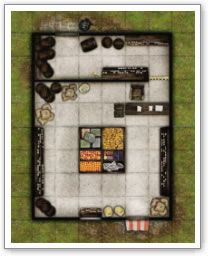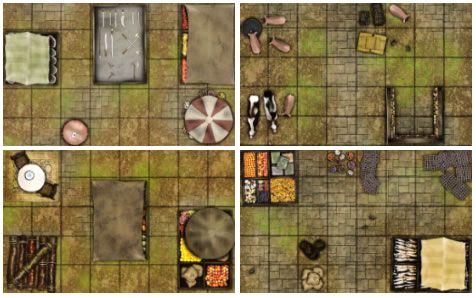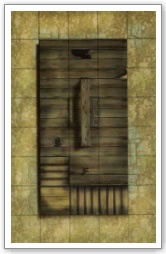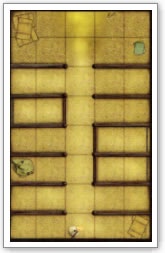Map Pack Village: General Store
A larger image of the store is available on the Map Pack: Village product page, but it's included here for completeness. It's made up of two tiles.
Now reading: Ctrl Alt Del
 | Deck of Many Cards |
A larger image of the store is available on the Map Pack: Village product page, but it's included here for completeness. It's made up of two tiles.
Now reading: Ctrl Alt Del
I’m happy to announce the birth of my new baby girl! Courtney Elizabeth Poppink was born at 12:26 on Tuesday, March 27th. She was 8 lbs, 4 oz at 21 inches at birth (smaller than both her brothers, amazingly). Courtney and my wife Heather are home safe and sound. Joshua (our five-year old) is creating lots of artwork for Courtney’s room, while Alex (our two-year old) is puzzled by the new baby.
Here's the new princess:
These four tiles can be arranged in multiple ways.
Now reading: Full Frontal Nerdity
The Gallows and Stable are both single tiles (at least I think the second tile is a stable, as it's not mentioned on the product page).

Now reading: Penny Arcade
Like the Shrine, the Apothecary is made up of two tiles.
Now playing: Citadels
I've decided to add more content to the site in the form of low-resolution images from the GameMastery Map Pack series. Each of the Map Pack product pages provides one or two sample pages, but I figure it's helpful to know what the rest of the cards look like if you're thinking about buying them.
I'm going to start with the two-tile Shrine in the Village set.
Now watching: The Punisher
 Others
Others
AG 34 - This mundane piton seems like the best choice for the immovable rod.
HH 23 - A spiked ball flail with a chain and wooden handle will serve as our rod of flailing.
HH 31 - The wooden mace with iron spikes and rope-wrapped handle seems right for the rods of alertness and thunder and lightning, both of which have the properties of light maces in combat. Metamagic
Metamagic
HH 73 - Shamanistic in appearance, this stained rod with pearls and animalistic bone head will be our rods rods of metamagic empower, metal and mineral detection, flame extinguishing, and enemy detection.
HH 74 - The rod with the flowering bulb head suggests growth, an attribute suitable for rods of metamagic enlarge, absorption, and security.
IP 37 - A metal rod with a serpent's head is a natural for rods of python, viper, and metamagic extend.
RW 72 - This steel rod with six multicolored gemstones immediately suggested the rods of wonder and lordly might, but I'd also recommend it for rods of rulership, splendor, and metamagic maximize.
RW 73 - Silent but deadly, this metal rod with ghostly cap and skull and bone motif will serve as rods of cancellation, negation, withering, metamagic silent, and metamagic quicken.
Now reading: Dungeon 145
Part 1 of this review covered the Contact, PC Registry, Basics, Calendar, and Map sections of the GameMastery Campaign Workbook.
Pages 46 to 252 are the Game Logs section, the bulk of the book and the most generic. The left hand side of two page spread is lined, and the right hand side has graph paper. This section could be used for dungeon maps, illustrations, encounter tables, flow charts, etc. It's nice to have the two types of paper alternate like this, although you accomplish much the same thing with two notebooks (and you'd probably have larger sheets of paper to boot).
Pages 254 to 303 present the NPC Registry, with room for two NPCs on each page. The basic information is the same as it is for PCs (name, classes, race, alignment, deity, ability scores, hit points, armor classes, and saves). There are boxes for attacks, skills, and feats and a three line notes section (much smaller than the corresponding notes and gear section in the PC Registry).
Pages 304 to 311 is the first half of the Item Cards section, with spaces for thirteen cards per page. Each card has a box for code and two lines for description. Pages 312 to 315 elaborate on this, detailing five cards per page with information like aura, caster level, cost, and construction. I started tracking the same information for my item cards in an Excel spreadsheet.
Pages 316 to 318 are lined pages for Quotes. Some gamemasters and players are really good at remembering notable quotes from their campaign sessions. I wish I were one of them. Page 319 is the Open Game License, and Page 320 is an advertisement for other GameMastery products (a little dated, as Dragon's Trove is listed as a Booster Pack for Item Cards).
I would have gotten a lot of use out of the Campaign Workbook in high school, when I was running homebrew campaigns and did not have a laptop. I would only recommend this product to someone who falls into both of those groups. Anyone who runs published adventures will probably not use most of the book, and anyone with a laptop can do track most of the book's contents more efficiently in DM's Familiar, Excel, and Word.
Now watching: Casino Royale
I received a complimentary copy of the GameMastery Campaign Workbook from Paizo one of the times I ordered five display boxes of Item Cards. While I enjoy free stuff as much as the next gamer, I left the book in its wrapping for several months, because I didn't expect I would use it much in my Age of Worms campaign. DM's Familiar does a great job of keeping track of PC and NPC stats, and my stack of Dungeon magazines provides most of the details on the campaign setting. However, I recently cracked it open to see what's inside, and discovered a few surprises. Among other things, the book has an area for tracking Item Cards (gotta love that cross marketing), so I decided to review it here.
The first thing I noticed about the book is that it is small (about 5" high and 4" wide). This makes it very portable, but it also requires the user to write relatively small. I compared the line spacing in the Game Log section with the notebooks I use at work, and it's about 2/3 the size.
Page 1 is a nice cover page with blanks for the campaign and gamemaster, and Page 2 has space more details about the two (contact information, setting, start and end dates). Pages 3 to 5 allow you to enter contact information for up to twelve players (including character names). Somewhere in here a gamemaster friend of mine would probably put warnings threatening players with dire consequences should they look further into the book.
Pages 6 to 19 contain the PC Registry, with a greatly reduced version of a typical character sheet. There are blanks for character name, classes, race, alignment, deity, ability scores, hit points, armor classes, saves, passive skills (Listen, Sense Motive, Spot), and status (dead, cursed, diseased, other). More than half of the page is a lined Notes and Gear section. I imagine this section of the book would get quite a workout over the course of a twenty level campaign, with lots of erasing required.
Pages 20 to 27 are the Basics section, with lined sections for campaign synopsis, major organizations, major villains, rules and rulebooks used, and house rules. Pages 28 to 39 are the Calendar, with one page per month (with spaces for the month and day of the week names). Pages 40 to 45 have graphed pages for the World Map, Continent, and Local Map and lined pages for listing locations on the facing pages. I usually write up this type of information in a campaign expectations document and distribute to the players at the beginning of the campaign.
Part two of this review covers the Game Logs, NPC Registry, and Item Cards sections.
Now playing: Ticket to Ride Europe
D&D rules dictate that a humanoid-shaped body can wear twelve magic items at a time (not counting two carried items like weapons or shields). I gave my players a pair of 9-pocket card holders with the pockets labeled by body part (and the related objects for that part). The players use them to keep their item cards organized and to see at a glance what items their characters have equipped. They also facilitate treasure distribution and shopping, as each character can see which body slots they have filled and which are still open.
Now watching: The Colbert Report
WARNING: This post produced strong feelings of nostalgia in the author. It may ramble a bit.
I first discovered Fiery Dragon's Counter Collections at Gamescape while living in California. I bought Counter Collection I and used it for my first campaign using D&D 3.0. The campaign centered around the Second Age of Middle Earth, when men of Numenor sailed the shores of Middle Earth and Sauron was crafting the rings with the help of Celebrimbor. Around the same time I helped edit a website about Middle Earth d20, which sadly no longer exists.
Shortly thereafter I won more Fiery Dragon counters during a mini-adventure writing contest on EnWorld.org. The adventure, Crocodile Tears, was about a hobgoblin ranger and his crocodile animal companion who laired in the fallen temple of a lost hobgoblin empire and hunted the lizardfolk who'd toppled that empire. I continued using the counters in Japan, where I ran a 3.0/3.5 campaign based on a original Dragonlance modules (and a short foray into Monte Cook's Banewarrens).
The counters were a great resource for a recent graduate (inexpensive) who played games at a pizza parlor (portable) in a homebrewed campaign (diverse). Claudio Pozas is an exceptional artist, and moving these counters around the battlemat was the way I learned 3.0/3.5 tactics. If I needed counters these days, I'd go for the Counter Collection Digital v2.0 Gold, which gives you digital versions of thousands of counters (from which you can print just the ones you need).
That said, I switched to minis as soon as I returned to the States, and I don't see myself ever going back to counters. There's something very compelling about three-dimensional gaming, and as I mentioned in a previous post it's possible to get a lot of very nice prepainted D&D minis these days.
Other DM Toolkit posts
Now playing: Category 5
Astute readers have probably gleaned that I admire the Shackled City and Age of Worms adventure paths, but it's more than that. I'm a huge fan of Dungeon Magazine in general, and eagerly await each issue. The last two years have seen a incredible upswing in content and layout, and I now regard it as one of my most important resources as a DM.
Adventures are the bulk of the magazine, of course. For the last two years the magazine has consistently presented three in each issue, one in each of three level ranges (1-5, 6-12, and 13-20). The stable of writers who regularly submit to Dungeon is top notch, and I learn a lot by reading the adventures, even those I doubt I'll ever have time to run. Paizo makes the adventure artwork from each issue available free online, which is another great resource.
Adventure paths and related Backdrop articles have doubled the value of the magazine from my perspective. They offer a compelling storyline that takes characters from 1st to 20th level over the course of twelve issues, with consistent artwork and recurring storylines. Other DMs provide plenty of commentary and suggestions about the adventure paths on Paizo's messageboards, so I'm never at a loss for NPC tactics or characterizations.
I also enjoy the editorials, letters, Campaign Workbook articles, and comics. The first thing I do when I get an issue in the mail is read Downer (the plot is complex, but the characters are intriguing and the illustrations are awesome). I even read the advertising, which is where I first heard about many of the things in my DM toolkit.
I highly recommend a subscription to Dungeon Magazine to all DMs out there. Whether you run prepackaged adventures or craft your own world, the material in Dungeon Magazine will lift your game to new heights.
Other DM Toolkit posts
Now playing: Robo Rally
 Elixirs
Elixirs
HH 57 - The fiery golden liquid returns again to represent the elixir of fire breath.
RW 42 - This round bottle with deep blue liquid containing tiny sparks of light will be our elixir of hiding.
RW 42 - The ageless white flower also makes a return as the elixir of love.
HH 55 - Previously pegged as the potion of displacement, this green glass bottle will double as the elixir of sneaking.
HH 50 - Pertaining to all things water, the potion with the octopus symbol is a natural for our elixir of swimming.
HH 53 - A thin glass bottle with oily green liquid containing an alien eye will serve as the elixirs of truth and vision. Misc
Misc
HH 53 - The eye is also an excellent choice for the potion of darkvision.
RW 42 - The dark liquid with motes of light is suitable for oils of darkness or daylight.
RW 43 - This clay bottle with wicker base and patterned bands can present the drinker with aid or good hope.
RW 46 - Like a good sports drink, this brown and tan swirled clay potion with nozzle tip offers up heroism.
RW 53 - The monk had to gulp down the finger, so let's make the barbarian wannabe's drink the worm. This dirty glass with the oily liquid lets the user rage.
Now watching: The Daily Show
When it comes to scenery for miniatures, I couldn't just stop at three different battlemats, Dwarven Forge, and WorldWorks. I have also purchased four Fantastic Locations (Fane of the Drow, Dragondown Grotto, Hellspike Prison, Fields of Ruin), three GameMastery Map Packs (Village, Graveyard, and Countryside), and two sets of Dungeon Tiles (Original and Arcane Corridors).
I love the cartography of the Fantastic Locations series, and they present a really interesting set of backdrops for encounters. They came in quite useful when I was playing D&D Miniatures Skirmish, but I haven't found a good way to work them into the Shackled City or Age of Worms campaigns (with the exception of the King's Road), so they're mostly taking up space at this point. I read through the adventures that came with each, but they don't grab me like those in Dungeon Magazine. The maps are also relatively flimsy, so they need to be laminated or treated with care.
The GameMastery Map Packs are in the same boat. The artwork is excellent, and the selection of tiles is quite good, but I've hardly used them since I picked up the first set at Gen Con 2006. Each piece is relatively small, and doesn't all the same tactical movement that a battlemat does. I remember that the ones on display were taped together to form larger pieces, but it's hard to store them that way. I thought about using some of the Graveyard and Village tiles for scenes in Diamond Lake, but the opportunity did not present itself.
I've only had the Dungeon Tiles for a few weeks, but I've already used them in my game. I really like the selection of large and small pieces. I haven't created any hallways or rooms yet, but the smaller pieces are great ornamentation in combination with Dwarven Forge. The pieces are also quite sturdy, so I don't mind letting my son play with them. I might give them more of a workout in my next session, to see how well they portray a mind flayer's lair. But for the time being it looks like they'll become a regular part of the toolkit.
Other DM Toolkit posts
Now playing: Acquire
It looks like it will be a while before I can scan any more item cards, but I'll get back to my DMG recommendations later this week. Before I do, I thought I'd look around for some other products to review.
Dragon's Trove, the next item card set, will be coming in May. The big news about this set is that it will be sold as a non-random set rather than as boosters. Mosaic on the Paizo boards noticed that Vincent Dutrait has given us our first preview of the set in the form of black and white images of nine of the items.
Also coming this summer is the GameMastery Critical Hit Deck. Assuming these bad boys have illustrations (and I've got to believe they do), I'll post scans of them here on the blog. Do these remind anyone else of swashbuckler cards?
I've always wanted to use a Deck of Many Things in a campaign. So it was great to see that Green Ronin had created an illustrated version. This would be another scan worthy purchase. I also just noticed Sean Reynold's variant Deck of Many Things using retraining and rebuilding rules. There's a free download with images for both the original and variant decks.
Now reading: Partially Clips
I started experimenting with WorldWorks cardstock models last fall. I enjoy all the Dwarven Forge pieces I have for dungeons and caverns, but I didn't want to spring for their Medieval Building or Accessories sets. I bought the InteriorWorks: Pubs & Inns set and used it to construct a tavern and a necromancer's laboratory for the Age of Worms campaign. Shortly thereafter I got the VillageWorks set to represent outdoor scenes. I'm currently making a lot of pieces from the ArenaWorks set for some upcoming gladiatorial games.
The most appealing thing about WorldWorks is the price. You can purchase a $12 or $15 set and then print as many models as you like. You do need to buy a cutting board, glue pens, and some other office supplies to get started, and you will be spending on ink cartridges and cardstock paper as you go along, but I've still spent less on WorldWorks than on a single large Dwarven Forge set.
The tradeoff for cost is time. The instructions suggest it takes 5-10 minutes to construct each model, but in my experience it's more like 15 minutes counting printing, cutting, gluing, and edging. It's hard to do anything else at the same time, although I was able to listen to several The Lord of the Rings commentaries.
The WorldWorks models are attractive, and there's a lot of variety. I put together a lot of furnishings (beds, tables, fireplaces, crates, etc) that I can use even when I'm using Dwarven Forge rooms or caverns. I really like the Masterboards (tiled flooring on a posterboard), and I've created a handful of them already. They make it convenient to pin down walls in advance and then place a whole scene on the gaming table in an instant.
Other DM Toolkit posts
Now reading: 300

01 Acid to 06 Bag of Marbles
07 Bedroll to 12 Caltrops
13 Candle to 18 Disguise Kit
19 Flask to 24 Holy Water
25 Ink & Quill to 30 Magnifying Glass
31 Manacles to 36 Pole
37 Pouch to 42 Saddle
43 Saddlebags to 48 Tent
49 Thieves Tools to 54 Whistle
Vincent Dutrait's composite image of the Adventure Gear set
Paizo's Adventure Gear product page
Now playing: Dead Rising
I'm not using my Steel Sqwire Flip-Mat, but I use their area of effect templates almost every week. The Spell Radius Package is getting the most use currently, as webs and fireballs are staples of the 5th-9th level game. The Straight and Diagonal Cone Packages have also been useful during the various dragon attacks of the Shackled City campaign.
I love the fact that the templates can be placed over miniatures without disturbing them. This is ideal for spells like web that stay in place. If I'm using my Dwarven Forge pieces they can just as easily rest on the walls of a room. I have other templates from the DDM Skirmish game and the Fiery Dragon Battlebox, but you have to hold them over the minis or move the minis aside and put them down for spells with a duration. In fact, I use the templates in DDM Skirmish games rather than the templates that come with DDM. So it's not surprising that Steel Sqwire is selling a Miniatures Skirmish Package.
All of my templates are the plain metal, as I bought them before the company made them available in the rubberized black, blue, or red. I don't think I'm likely to buy another set, as I haven't seen a need for more in the campaign. I did get a free 20 ' radius template (and a free Enlarge Person Stat Card) when I ordered them, otherwise I might feel that I was lacking something (for when a fireball goes off in a room that has already been webbed).
Other DM Toolkit posts
Now watching: Rome
 49 Thieves Tools
49 Thieves Tools
50 Tinderbox
51 Torch
52 Waterskin
53 Whetstone
54 Whistle
Now playing: Munchkin 4: The Need for Steed